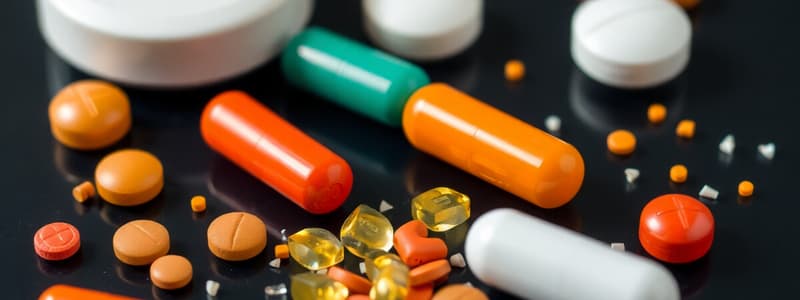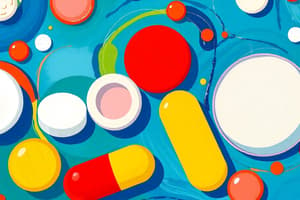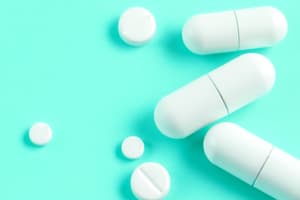Podcast
Questions and Answers
What is one characteristic of mannitol when used in chewable tablets?
What is one characteristic of mannitol when used in chewable tablets?
- It is tastier than lactose. (correct)
- It is less tasty than lactose.
- It enhances tablet strength.
- It reduces disintegration time.
What is one function of lubricants in tablet formulation?
What is one function of lubricants in tablet formulation?
- To prevent powder/metal adherence. (correct)
- To increase tablet strength.
- To enhance disintegration.
- To provide binding agents.
How does magnesium stearate affect disintegration time?
How does magnesium stearate affect disintegration time?
- It eliminates disintegration entirely.
- It prolongs disintegration time. (correct)
- It enhances drug dissolution.
- It decreases tablet porosity.
Which of the following is a disadvantage of using magnesium stearate?
Which of the following is a disadvantage of using magnesium stearate?
Which of the following statements regarding sodium stearyl fumarate is correct?
Which of the following statements regarding sodium stearyl fumarate is correct?
What is the recommended usage of binding agents in tablet formation?
What is the recommended usage of binding agents in tablet formation?
What is a benefit of using granules over powders in tablet formulation?
What is a benefit of using granules over powders in tablet formulation?
What effect do lubricants have on the flow properties of tablet components?
What effect do lubricants have on the flow properties of tablet components?
What is the primary purpose of excipients in a dosage form?
What is the primary purpose of excipients in a dosage form?
Which property is NOT desirable for an ideal excipient?
Which property is NOT desirable for an ideal excipient?
What potential effect can excipients have on drug formulations?
What potential effect can excipients have on drug formulations?
Which of the following statements about excipients is incorrect?
Which of the following statements about excipients is incorrect?
What does the term 'bulk up' refer to in the context of excipients?
What does the term 'bulk up' refer to in the context of excipients?
Which is an example of a role that excipients can play in drug stability?
Which is an example of a role that excipients can play in drug stability?
What is the primary focus of Good Manufacturing Practices (GMP) in the context of excipients?
What is the primary focus of Good Manufacturing Practices (GMP) in the context of excipients?
What is the significance of complying with BP, PhEur, and USP-NF standards for excipients?
What is the significance of complying with BP, PhEur, and USP-NF standards for excipients?
What is the primary function of water as an excipient in liquid preparations?
What is the primary function of water as an excipient in liquid preparations?
Which of the following co-solvents does NOT enhance solubility in liquid preparations?
Which of the following co-solvents does NOT enhance solubility in liquid preparations?
What is the primary role of buffers in liquid preparations?
What is the primary role of buffers in liquid preparations?
Which statement regarding antimicrobial agents in liquid formulations is incorrect?
Which statement regarding antimicrobial agents in liquid formulations is incorrect?
What is a significant drawback of using water as an excipient in liquid formulations?
What is a significant drawback of using water as an excipient in liquid formulations?
What is the function of antioxidants in liquid formulations?
What is the function of antioxidants in liquid formulations?
What is the purpose of wetting agents in a liquid formulation?
What is the purpose of wetting agents in a liquid formulation?
Which property of HPMC makes it suitable for controlling drug release in formulations?
Which property of HPMC makes it suitable for controlling drug release in formulations?
What is one of the roles of excipients in drug formulation?
What is one of the roles of excipients in drug formulation?
How did changing from calcium sulfate to lactose in phenytoin capsules affect the drug's bioavailability?
How did changing from calcium sulfate to lactose in phenytoin capsules affect the drug's bioavailability?
What consequence did the use of diethylene glycol instead of glycerin have in pharmaceuticals?
What consequence did the use of diethylene glycol instead of glycerin have in pharmaceuticals?
What characteristic of calcium sulfate contributed to its prolonged release of phenytoin?
What characteristic of calcium sulfate contributed to its prolonged release of phenytoin?
What is a potential adverse effect of excipients in medicinal formulations?
What is a potential adverse effect of excipients in medicinal formulations?
What role do excipients play in maintaining drug integrity during storage?
What role do excipients play in maintaining drug integrity during storage?
Which of the following interventions is crucial when selecting excipients for drugs with a narrow therapeutic index?
Which of the following interventions is crucial when selecting excipients for drugs with a narrow therapeutic index?
What main benefit does lactose provide over calcium sulfate in drug formulations?
What main benefit does lactose provide over calcium sulfate in drug formulations?
What is the primary function of disintegrating agents in tablets?
What is the primary function of disintegrating agents in tablets?
Which of the following is NOT a method by which disintegrating agents can function?
Which of the following is NOT a method by which disintegrating agents can function?
Which polymer is used for enteric coating and is known for its acid resistance?
Which polymer is used for enteric coating and is known for its acid resistance?
What role do glidants serve in granulation?
What role do glidants serve in granulation?
What is an example of a superdisintegrant used in tablet formulations?
What is an example of a superdisintegrant used in tablet formulations?
Which of the following statements about coatings is FALSE?
Which of the following statements about coatings is FALSE?
What effect does colloidal silica have in granulation?
What effect does colloidal silica have in granulation?
Which of the following materials is typically associated with wet granulation technology?
Which of the following materials is typically associated with wet granulation technology?
What is a potential consequence of using glucose and sucrose as excipients?
What is a potential consequence of using glucose and sucrose as excipients?
Which of the following excipients is associated with severe allergic reactions?
Which of the following excipients is associated with severe allergic reactions?
Which excipient may lead to Central Nervous System effects, particularly in neonates?
Which excipient may lead to Central Nervous System effects, particularly in neonates?
What is the primary role of diluents or bulking agents in tablets?
What is the primary role of diluents or bulking agents in tablets?
Which of the following excipients can be toxic in phenylketonuria patients?
Which of the following excipients can be toxic in phenylketonuria patients?
What characteristic makes spray dried lactose suitable for direct compression?
What characteristic makes spray dried lactose suitable for direct compression?
Which excipient is noted for its consistent inert properties?
Which excipient is noted for its consistent inert properties?
Which of these diluents is commonly associated with good flow characteristics?
Which of these diluents is commonly associated with good flow characteristics?
What is the main concern regarding the use of colourants like tartrazine?
What is the main concern regarding the use of colourants like tartrazine?
Which excipient allows for powder free flow and does not require granulation during tablet production?
Which excipient allows for powder free flow and does not require granulation during tablet production?
Flashcards
What are excipients?
What are excipients?
Substances added to a dosage form that are not therapeutically active.
How can excipients impact drug absorption?
How can excipients impact drug absorption?
Excipients can affect how well a drug is absorbed into the bloodstream.
What are some practical applications of excipients?
What are some practical applications of excipients?
Excipients are used to make tablets easier to manufacture, administer, and identify.
How can excipients control drug release?
How can excipients control drug release?
Signup and view all the flashcards
What role do excipients play in drug stability?
What role do excipients play in drug stability?
Signup and view all the flashcards
What are some ideal properties of an excipient?
What are some ideal properties of an excipient?
Signup and view all the flashcards
What are the quality standards for excipients?
What are the quality standards for excipients?
Signup and view all the flashcards
How are excipients manufactured?
How are excipients manufactured?
Signup and view all the flashcards
Excipients: What are they?
Excipients: What are they?
Signup and view all the flashcards
Roles of Excipients
Roles of Excipients
Signup and view all the flashcards
Excipients & Bioavailability
Excipients & Bioavailability
Signup and view all the flashcards
Excipient Change Example: Phenytoin
Excipient Change Example: Phenytoin
Signup and view all the flashcards
Excipient Safety: Diethylene Glycol Case
Excipient Safety: Diethylene Glycol Case
Signup and view all the flashcards
Excipients & Side Effects
Excipients & Side Effects
Signup and view all the flashcards
Excipient Importance in Drug Development
Excipient Importance in Drug Development
Signup and view all the flashcards
Excipients: Hidden Heroes
Excipients: Hidden Heroes
Signup and view all the flashcards
Mannitol
Mannitol
Signup and view all the flashcards
Tablet excipients
Tablet excipients
Signup and view all the flashcards
Binding agents
Binding agents
Signup and view all the flashcards
Post-mixing lubricant
Post-mixing lubricant
Signup and view all the flashcards
Lubricants in tablet making
Lubricants in tablet making
Signup and view all the flashcards
Effects of Lubricants
Effects of Lubricants
Signup and view all the flashcards
Magnesium Stearate
Magnesium Stearate
Signup and view all the flashcards
Sodium Stearyl Fumarate
Sodium Stearyl Fumarate
Signup and view all the flashcards
Granulating Agents (Binders)
Granulating Agents (Binders)
Signup and view all the flashcards
Starch (Binder)
Starch (Binder)
Signup and view all the flashcards
Polyvinylpyrrolidone (PVP) (Binder)
Polyvinylpyrrolidone (PVP) (Binder)
Signup and view all the flashcards
Glidants
Glidants
Signup and view all the flashcards
Colloidal Silica (Glidant)
Colloidal Silica (Glidant)
Signup and view all the flashcards
Disintegrating Agents
Disintegrating Agents
Signup and view all the flashcards
Superdisintegrants (Starch, Croscarmellose Sodium)
Superdisintegrants (Starch, Croscarmellose Sodium)
Signup and view all the flashcards
Pregelatinised Starch (Disintegrant)
Pregelatinised Starch (Disintegrant)
Signup and view all the flashcards
HPMC and xanthan gum
HPMC and xanthan gum
Signup and view all the flashcards
Water as an Excipient
Water as an Excipient
Signup and view all the flashcards
Water-miscible co-solvents
Water-miscible co-solvents
Signup and view all the flashcards
Buffers in liquid formulations
Buffers in liquid formulations
Signup and view all the flashcards
Antimicrobial agents
Antimicrobial agents
Signup and view all the flashcards
Antioxidants
Antioxidants
Signup and view all the flashcards
Wetting agents
Wetting agents
Signup and view all the flashcards
Excipients
Excipients
Signup and view all the flashcards
Diluents or Bulking Agents
Diluents or Bulking Agents
Signup and view all the flashcards
Lactose (α-lactose monohydrate)
Lactose (α-lactose monohydrate)
Signup and view all the flashcards
Spray Dried Lactose
Spray Dried Lactose
Signup and view all the flashcards
Microcrystalline Cellulose
Microcrystalline Cellulose
Signup and view all the flashcards
Disintegrants
Disintegrants
Signup and view all the flashcards
Binders
Binders
Signup and view all the flashcards
Lubricants
Lubricants
Signup and view all the flashcards
Colorants
Colorants
Signup and view all the flashcards
Study Notes
MPharm Programme - Excipients
- Excipients are minor components of dosage forms, often present in very small quantities (e.g., 1 in 1000).
- They are not therapeutically active but serve a purpose, such as bulking up the drug.
- Excipients are crucial in controlling the behaviour of dosage forms, impacting bioavailability (e.g., how much drug reaches the blood).
- Excipients influence drug release and stability, potentially affecting the rate of drug absorption.
- Example excipients include tablets, facilitating manufacture, administration, and identification of drugs, regulating consistent release and promoting stability or protecting drugs.
Excipient – Ideal Properties
- Ideal excipients are stable and reproducible.
- They should have no unintended interactions with the drug (no chemical reactions).
- Excipients are pharmacologically inert, meaning they do not affect the drug's activity.
- They must deliver the desired function.
- Cost-effectiveness is a key factor.
- They must comply with pharmaceutical standards (e.g. BP PhEur, USP-NF, manufactured under GMP).
Excipients – Role
- Excipients aid in the processing of drug delivery systems during manufacturing.
- They protect, support, or enhance stability, bioavailability, and patient acceptability.
- They assist in product identification and improving the drug's safety profile.
- They facilitate drug effectiveness and/or delivery, and maintain the drug product's integrity during storage
Excipients – Safety
- In the 1960s, replacing calcium sulfate with lactose in phenytoin capsules affected bioavailability, increasing the mean serum phenytoin concentration by 4.5-fold. Lactose is soluble in water, while calcium sulfate is less soluble, thus influencing drug release. Lactose gave an immediate, large release, while calcium gave a prolonged release.
- Diethylene glycol (antifreeze) was used as a cough syrup ingredient in 2007, leading to health problems (e.g., nephrotoxicity, hepatotoxicity).
Excipients – Adverse Effects
- Some excipients can cause side effects.
- Examples include glucose/sucrose (linked to obesity and tooth decay), benzyl alcohol (gassing syndrome in neonates), ethanol (CNS effects), aspartame (phenylketonuria), polyoxyl castor oils (anaphylactoid reactions).
- Propylene glycol (CNS effects in infants and young children), and colourants (hypersensitivity and behavioural disturbances), can negatively affect patient health.
Tablet Compression/Compaction
- Tablet compression involves precise positioning of granules or powders.
- Granules flow into a die cavity and are compressed into a tablet.
- Movements of punches and hopper shoes shape and form the tablet, ensuring smooth ejection.
Tablet Excipients (Diluents/Bulking Agents)
- Diluents (fillers) are added to create the correct size for tablets, for handling, and to improve properties like taste and solubility/dissolution (e.g., lactose).
- Lactose, a common filler, is known for its pleasant taste and low hygroscopicity (moisture absorption, preventing clumping), in addition it is inert.
- Common diluting agents include lactose, sucrose, calcium phosphate dihydrate, glucose, calcium carbonate, mannitol, and cellulose, to name a few.
- Spray-dried lactose is also commonly used for direct compression (DC).
- Microcrystalline cellulose improves the direct compression process as well.
- Mannitol is often used for chewable tablets.
Tablet Excipients (Lubricants)
- Lubricants prevent powder/metal adherence to ensure smooth ejection from the die, improve flow properties of the drug substances, prolong disintegration time, and reduce drug dissolution.
- Magnesium stearate, used widely up to 1% w/w, acts as a good lubricant, hydrophobic.
- Sodium stearyl fumarate is hydrophilic, sometimes used in preference.
Tablet Excipients (Binding Agents)
- Binding agents adhere particles together, improving tablet integrity.
- They are commonly added during granulation as dry powder or solutions.
- Examples include starch and polyvinylpyrrolidone (PVP).
Tablet Excipients (Glidants)
- Glidants improve powder/granule flow, reducing interparticulate friction, and smoothing surface irregularities.
- Examples include colloidal silica.
Tablet Excipients (Disintegrating Agents)
- Disintegrating agents increase tablet surface area when wetted, triggering the tablet to break apart.
- Starch, croscarmellose sodium, and pregelatinised starch function as disintegrating agents.
- Lyophilised tablets generally disintegrate quickly in water.
Tablet Excipients (Dyes & Flavouring Agents)
- These agents enhance tablet taste and appearance, e.g., colouring agents, flavours.
- Film and sugar coatings, e.g., sucrose, are frequently used in tablets.
Excipients for Liquid Preparations (Water)
- Water, a commonly used liquid excipient, is physiologically non-toxic and compatible.
- It helps dissolve ingredients.
- However, it can support microbial growth and be prone to hydrolysis, so careful consideration is required.
- Water also supports chemical reactions.
Excipients for Liquid Preparations (Water Miscible Co-Solvents)
- Water-miscible co-solvents help enhance solubility, taste, and stability.
- Common examples include propylene glycol, glycerol, and ethanol.
Excipients for Liquid Preparations (Buffers)
- Buffers control pH, promoting stability, and maintaining physiological compatibility within the liquid.
- They also act to improve dissolution.
Excipients for Liquid Preparations (Antimicrobial Agents)
- These agents prevent the growth of microbes (from excipients or the environment )within the liquid.
- Preservatives are key examples.
Excipients for Liquid Preparations (Antioxidants)
- Antioxidants prevent oxidation of various components in the liquid formulation, as well as components from excipients.
Excipients for Liquid Preparations (Wetting Agents)
- Wetting agents decrease interfacial tension in liquids, allowing for better spreading, especially important with hydrophobic drugs.
- Surface-active agents and hydrophilic colloids aid this activity.
Excipients for Liquid Preparations (Antifoaming Agents)
- Antifoaming agents control foam formation in liquids.
Excipients for Liquid Preparations (Thickening Agents)
- Thickening agents stabilise suspensions, improving viscosity.
- Methylcellulose is a good example
Excipients for Liquid Preparations (Sweetening Agents)
- Sweetening agents add sweetness to the preparations.
Excipients for Liquid Preparations (Flavouring Agents)
- Natural and/or artificial flavouring agents enhance the taste of prepared liquids.
Excipients for Liquid Preparations (Humectants)
- Humectants absorb moisture from the atmosphere, preventing drying of the liquid formulation, and maintaining consistency, especially for external formulations (e.g., glycerol, PEGs).
Studying That Suits You
Use AI to generate personalized quizzes and flashcards to suit your learning preferences.




